Posts in Category: Photography
The Last Supper with More Than a Grain of Salt 2
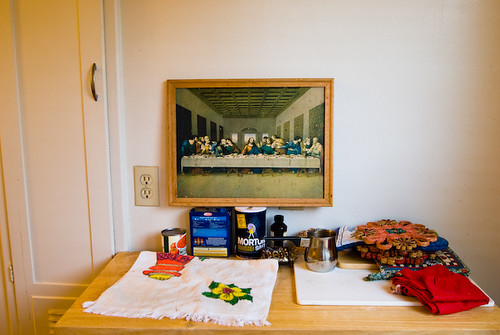
The Last Supper with More Than a Grain of Salt 2, originally uploaded by neocles.
This print of the last supper had always hung near the breakfast table in my parents’ home. It was no different here at my mother’s last apartment, although it had fallen off the wall and sat around for a few months. I set it back here the other day, and it seemed a fine place for photo. A detail shot would reveal drops of this and that, and a spattering of tomato sauce.
It is a bit of an odd assortment off things on the cupboard, most sitting for weeks without notice from mom. Tomato sauce, orzo, salt, vanilla flavoring, the Greek coffee pot (the briki), and assorted trivets. A couple times in recent months my mom had cooked food with some odd flavorings, like baked chicken with a heavy dose of cinnamon or ground cloves. Eventually she gave up on seasonings and then finally on cooking much of anything besides boiled eggs, green beans, or broccoli.
Today, we went to Kaiser for an eye check-up and to start the process of getting a new pair of glasses. She had misplaced her only pair. It turns out that her right eye needs just about the strongest lens available. The doctor could not determine a prescription for the left eye at all because she is nearly blind from a cataract. So, we’ll be going back for cataract removal, and then eventually for a prescription for the left eye. Shit, no wonder the apartment was a mess. And no wonder the chicken was seasoned with salt and clove instead of salt and pepper.
Suitcase 4

Suitcase 4, originally uploaded by neocles.
I’m slowly making my way through photographing the items in my mother’s apartment. I only vaguely remember the suitcase. It was not used very often. In fact, the only time I remember it being used was when my mom visited Greece once. When we moved my mother up here we just packed it full of curtains she had made for her house. She would not let me throw them away.
The chair and end table are part of a set purchased when we moved into a new house my dad had built on Griffith Way in Fresno, back in 1967. There are two chairs and couch which, unfortunately, were reupholstered around 1980. The sofa was cobalt blue and I’ll never forget that thing. But I can’t quite picture the original color of the chairs.
The furniture all has to be gotten rid of soon. I was all ready for that. But now I feel more sad about seeing it all go. I had a fantasy while I was going through stuff the other day that I could move my mom back into her house in Fresno and find a wonderful, reliable, relatively inexpensive 24/7 live-in caretaker for her. Then all the power objects could stay together for another couple years. But these childish dreams must be left behind…
Leaving Home For Good – Family Snapshot
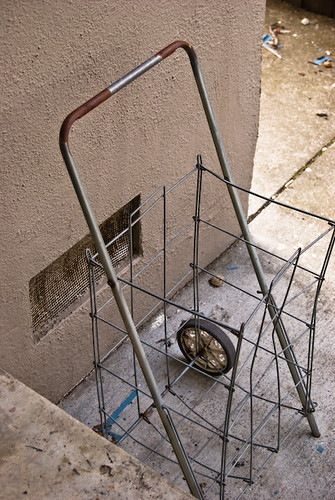
The Grocery Cart #2, originally uploaded by neocles.
My mother, Efrosini Serafimidis, will be 90 years old this month. For the last five years she has been living down the street from us in a little one bedroom apartment. We moved her up here to Albany from Fresno and the home in which she had lived for over 30 years. I was resistant to moving her at the time, but my cousins insisted it was necessary. It is not easy for a person in their 80’s to switch gears like that. She still complains bitterly everyday about this place, and I think she still is a little resentful towards me on that count. But she did okay for two or three years.
The last couple years have been increasingly challenging. She has had a hip replacement and big surgery on a broken elbow. Also, she has been pretty lonely during the days when we are at work, and the lack of interaction and stimulation has taken a toll on her.
The next move is now necessary. This month, Effie will be going to a board and care facility somewhere nearby. It is going to be hard to do, and the transition is going to be a struggle, I’m sure. But her hips are not holding her up very well, and she is suffering from some dementia. She has wandered off a couple times, but her incredible luck with coming across non-Greek-speaking people who are charmed by her old-country, head-scarved, four-foot-ten-inch figure has held up. Each time we got her back none the worse for the wear.
Of course, Sarah and I both work full time, and have a five-year-old to attend to. And living in the Bay Area has its own challenges. So, I would not say I have been an overly conscientious caregiver, but nonetheless, I see her and give her her meds almost every day, try to keep her reasonably safe and fed, bring her back and forth to my home, clean her apartment, pay her bills, take care of her legal and financial matters, manage the renting of the family home in Fresno, and so on.
Chief among the challenges of moving her to a care facility is going to be the dissolving of her apartment home and figuring out what to do with all the things in it. We got rid of a lot of stuff when we moved her to Albany. But a lot of stuff is still packed away in her apartment. I am very nostalgic about these things and have a tough time just trashing them even though they are otherwise pretty worthless.
In response to all this I am planning a photo series. Right now the idea is simple snapshot-like photos of, basically, every object in her apartment. Where possible, descriptions will accompany the photos. Eventually, the series will include photos of each and every object I still have from my parents. I may be an old man myself by the time I finish.
Purple Nova at the French School

Purple Nova at the French School, originally uploaded by neocles.
I noticed the purple Nova while biking to work one morning. The intense color caught my eye. I took a couple shots, and I noticed right away on the camera that the color was not as bright and not as purple in the image. This was true on the computer as well, and I sort of forgot about it for a while. I didn’t think it would amount to much.
A couple weeks later, I started fooling around with the post-processing work on it, and got something I rather liked. I eventually uploaded something to flickr, and it suddenly turned out to be one of the more interesting and popular things I’d produced in awhile. (Bear in mind that I measure these metrics in small fractions of what most flickr pop stars do, so my data set is pretty limited. Nonetheless it seems meaningful to me!) I guess the moral of the story is that you can never tell what is going to resonate with people. At least I can’t.
Flip-book Life
We recently took a trip to Seattle for our dear friend Jen Dixon’s birthday. Jen’s friends from all over the country came for this one, and so we saw a lot of people. We had a wonderful time, and it was actually rejuvenating. It just felt like we reconnected with our friends there in a much more significant way this time. I suppose that because it was a tough year marked by personal loss, and because we saw people we had not seen in years, and because we are all older, there was this pervasive sense that being with people you care for is what matters in life. It sounds corny, but I don’t know how else to describe it.
One of the really nice things we had a chance to do was take a drive up Aurora Ave to see Jen’s public art work installed on the Interurban Trail. I really loved the work. It has a playfulness and a sense of place. Yet the combination of the simple, colorful, unfolding content on a form usually reserved for the concise delivery of important information for travelers creates a semiotic mystery. “What does that sign mean? What is it telling me about what’s ahead?” I love that in a work.
Night Rambler 5
It showed up one day earlier this week. It sat quietly over to the side minding its own business, not making a peep. I went by once and noticed it immediately, but I, too, didn’t say anything. Life is like that a lot these days. One makes mental notes and tries to find them later amid the clutter of scraps of paper, children’s toys, empty wine bottles, and job postings.
I went by again and the tug was more insistent; the mental note came floating down from the rafters, landed in plain view. For two days I shuffled it to the top of the stack of other mental notes.
Sarah had noticed it sitting there and said something to me about it. Tuesday night it was still there when I left the house to run the errand in another note. I threw my tripod in the car on my way to get milk.
On the way back home, i went by again. This time I stopped. I didn’t care that it was night. The moon was almost full. The golden convertible gleamed in the cocktail glow of moonlight and sodium vapor.
It was accidental at the time, brought about by the time constraints of modern suburban living. But these two great tastes taste great together: suburban neighborhood car photography, and night photography.
a poem for our times
The Second Coming
Turning and turning in the widening gyre
The falcon cannot hear the falconer;
Things fall apart; the centre cannot hold;
Mere anarchy is loosed upon the world,
The blood-dimmed tide is loosed, and everywhere
The ceremony of innocence is drowned;
The best lack all conviction, while the worst
Are full of passionate intensity.
Surely some revelation is at hand;
Surely the Second Coming is at hand.
The Second Coming! Hardly are those words out
When a vast image out of Spiritus Mundi
Troubles my sight: somewhere in sands of the desert
A shape with lion body and the head of a man,
A gaze blank and pitiless as the sun,
Is moving its slow thighs, while all about it
Reel shadows of the indignant desert birds.
The darkness drops again; but now I know
That twenty centuries of stony sleep
Were vexed to nightmare by a rocking cradle,
And what rough beast, its hour come round at last,
Slouches towards Bethlehem to be born?
William Butler Yeats
Throwing (away) the hand grenade
Here is a train of thought that moves from photography to childhood, and the change in outlook that occurs over time.
Joe turned me on to a wonderful post on The Year In Pictures about a Washington Post article on Diane Arbus. In it, some of her subjects were interviewed 40 years after they were photographed as children. Of course, one of the famous images discussed therein is that of the “grenade boy”. The subject, Colin Wood, talks about how, for a time, he was very interested in guns and grenades, and how this led his teachers to believe he was deeply troubled and in need of therapy.
This brought to mind my own childhood obsession with guns and war, World War II in particular. I played with army men, built models of tanks and planes, and played with toy guns for years. My friend Doug and I used to march around with replica WWII firearms and army surplus gear even in seventh grade. Kids where I grew up did not do this in the 70s
I used to make tiny little flags for the army men. I’d get an old sheet and cut tiny little rectangles and color them with crayon or felt tip markers. Mostly it was American, British, and German. They were pretty good, too. Once when I was in 5th or 6th grade, I was playing during recess with a few army men I had brought to school. Among them was a German flag, which had, of course, a swastika. To me this was just historically accurate, as I had German soldiers. But to some teacher it was extremely distressing. I got hauled in and lectured and had to stay after school. The offending item was taken away and destroyed, of course. And I was told, “you can’t just bring that to school and play with it. You just don’t understand what that means, what it stands for.” In fact, I did, and I didn’t. I knew in a matter-of-fact way exactly what it stood for, since I constantly read all about it and knew perfectly well what the Third Reich did. But I had no real emotional sensitivity to the reality of it all, the suffering, the inhumanity of the deeds; I just had a kind of text book understanding. I had no idea what the emotional meaning was for people a mere 25 years or so after the end of the war.
When I started junior high, I took as an elective class something called military science. We did a lot of military drilling, learned how to read maps, practiced target shooting, and once a week we came to school in uniform. This was the California Cadet Corps. It was a pretty geeky thing to do at the time (1974), because kids were growing their hair, hanging out, smoking cigarettes or pot, and trying to figure out the opposite sex (or whatever sex they were attracted to).
I stuck with it through the seventh and into the eighth grade. During my eighth grade year Fort Miller Junior High became a “renaissance school”. This just meant that they were bringing in a hard-ass dean of boys and dean of girls, cracking down on bad behavior and getting back to the basics. So, at one point the decision was made to entirely close the east fields during breaks and lunch to make it easier to police the smokers, etc.
Naturally, there was a huge outcry. It was going to upset all the social patterns to simply lop off 50% of the open space. So, the students did what students did in those days: they had a sit-in in the east field to protest the closure. I participated as we sat there through lunch and 6th period. It happened to be on a Friday, which was cadet uniform day. The protest led to some dialog with the school about use of the field, no one got in trouble, we got some limited use back.
But in the meantime, the next Monday, something awful happened. Naturally, the cadets in the protest were easy to spot. I got called into Mr. (Lieutenant) Eggers office where I got busted down from master sergeant–and Battalion Supply Sergeant–to corporal. This was for bad behavior while in uniform. I was totally bummed. (This was on top of some other minor trouble that I got into over the summer when our battalion went to summer camp at Camp San Louis Obispo. A friend and I had wandered over and climbed onto a couple old Japanese tankettes mounted as display pieces on the parade grounds.) I had started to see, and now it was painfully clear, that military life was not for me. Any wandering off the narrow line was not tolerated. Any questioning of authority and free thinking could not be tolerated. I was not all that good at keeping myself from questioning things, or from straying away when I was supposed to be marching in lockstep. And I could not see the sense of some of the many, many rules laid down. I could not see why exercising my voice in protest was a source of shame for the Corps. That’s not to say there is not in fact a point to these things. But I, the 14-year-old, did not see it. In any case, it was a turning point for me.
I quit the Cadets the next quarter. I lost interest in all things military. I got more into rock and roll. I started reading Carlos Castaneda, I started… well I’ll leave the rest of that thread for another time. For now, let’s just say I ended up studying philosophy, living in Berkeley, taking up photography, and appreciating the work of Diane Arbus.

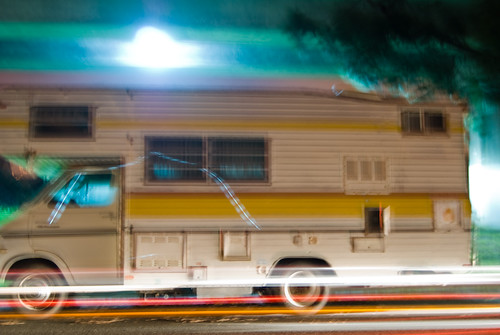

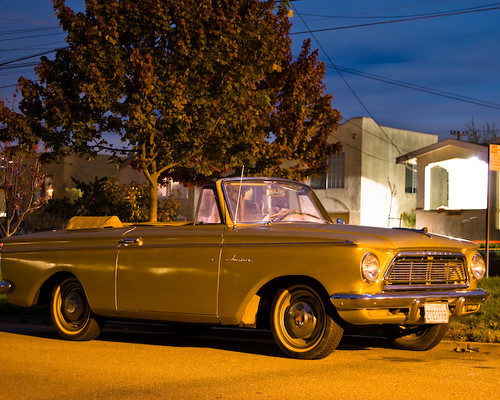
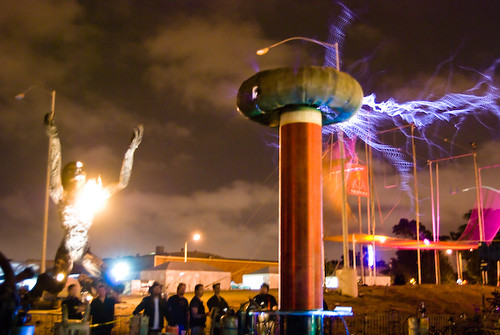

You must be logged in to post a comment.